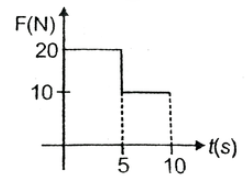Is the work required to be done by an external force on an object on a frictionless , horizontal surface to accelerate it from a speed v to a speed 2v
equal to the work required to accelerate the object from t=0 to v.
twice the work required to accelerate the object from v=0 to v.
three time the work required to accelerate the object from v=0 to v.
four time the work required to accelerate the object from 0 to v. Or
The correct Answer is:C
The net work needed to accelerate the object from v=0 to v is
W1=KE1f−KE1i=12mv2−12m(0)2=12mv2
The work required to accelerate the object from speed v to speed 2v is
W2=KE2f−KE2i=12m(2v)2−12mv2
=12m(4v2−v2)=3(12mv2)=3W1
Topper's Solved these Questions
- WORK, ENERGY, POWER AND COLLISIONBOOK - A2ZCHAPTER - WORK, ENERGY, POWER AND COLLISIONEXERCISE - Potential Energy, Conservative And Non-Conservative Forces
28 Videos
- WORK, ENERGY, POWER AND COLLISIONBOOK - A2ZCHAPTER - WORK, ENERGY, POWER AND COLLISIONEXERCISE - Conservation Of Mechanical Energy And Linear Momentum
24 Videos
- WORK, ENERGY, POWER AND COLLISIONBOOK - A2ZCHAPTER - WORK, ENERGY, POWER AND COLLISIONEXERCISE - Chapter Test
29 Videos
- WAVES AND ACOUSTICSBOOK - A2ZCHAPTER - WAVES AND ACOUSTICSEXERCISE - Chapter Test
30 Videos
Similar Questions
Knowledge Check
A truck accelerates from speed v to 2v. Work done during this is
Athree times as the work done in accelerating it form rest to vBsame as the work done in accelerating it form rest to vCfour times as the work done in acceleration it from rest to vDless than the work done in acclerating it from rest to vA truck accelerates from speed v to 2v. Work done during this is
Athree times as the work done in accelerating it from rest to v.Bsame as the work done in accelerating it from rest to v.Cfour times as the work done in accelerating it from rest to v.Dless than the work done in accelerating it from rest to vA truck accelerates from speed v to 2v. Work done in during this is
Athree times as the work done in accelerating it from rest to vBsame as the work dine in accelerating it from rest to vCfour times as the work done in accelerating it from rest to vDless than the work done in accelerating it from rest to v
Force is applied on an object of mass 2 kg at rest on a frictionless horizontal surface as shown in the graph. The speed of object at t = 1s is will be F (N) 20 10 t(s) 10 5
View SolutionTwo identical bodies of mass 4 kg each are approaching each other with a speed of 3 m/s , on a frictionless horizontal surface . When the two bodies collide , they stick together and come to rest . Calculate the work done by the external forces and internal forces on the system of blocks .
View SolutionTwo identical 5kg blocks are moving with same speed of 2m/s towards each other along a frictionless horizontal surface . The two blocks collide , stick together and come to rest. Consider the two blocks as a system . The work done by the external and ijnternal force are respectively:
View SolutionIf F is the force required to keep a train moving at a constant speed v, the power required is :
View SolutionIf F is the force required to keep a train moving at a constant speed v, the power required is :
View Solution

